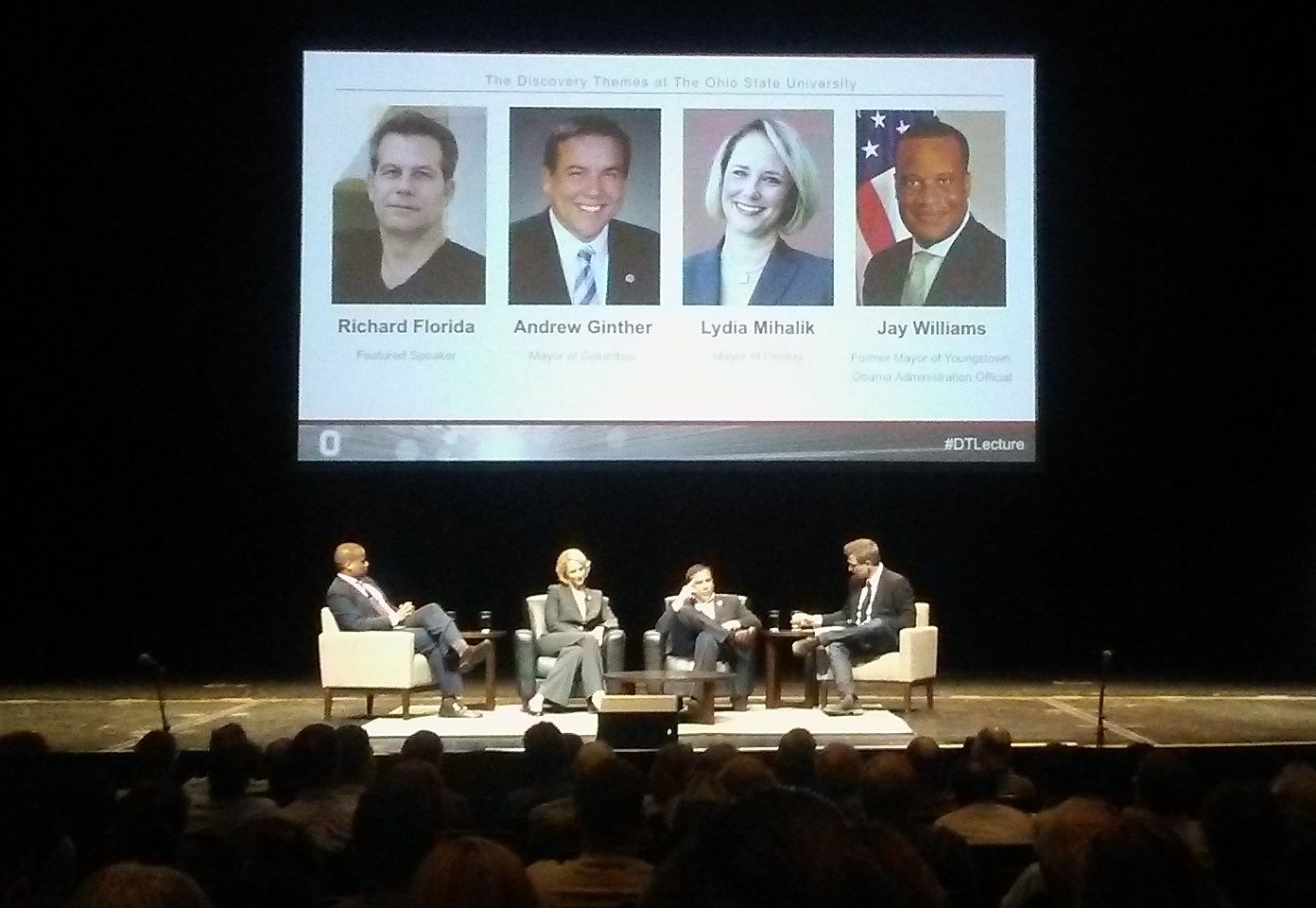The past decade has seen considerable progress as job growth has remained steady and communities across the state have experienced promising comebacks.
GOPC Executive Director Visits with Ohio Congressional Leaders
GOPC Executive Director, Alison Goebel, met with staff for Congressman Tiberi and Congressman Turner to urge them to maintain critical community revitalization programs in the forthcoming federal budget. Goebel was one of thirty leaders participating in a Hill Day for smart growth groups from around the country.
Programs that have been critical to the stabilization and revitalization of Ohio’s small and large communities are under threat, including Low Income Housing Tax Credits, and Community Development Block Grant funding (CDBG) and HOME dollars, which support everything from greening programs to affordable housing preservation. TIGER grants, the funding source for a number of innovative transportation projects that make Ohio’s communities more attractive and competitive, are also under threat.
Staff in Congressman Tiberi’s office and Congressman Turner’s office both acknowledged the importance of these programs to their districts and the entire state of Ohio.
With more than 45 congressional visits scheduled, GOPC and its peer organizations are hopeful that these invaluable programs remain in place moving forward.
GOPC To Attend Conferences Around Ohio This Fall
Emerging Land Use Trends Revealed in New ULI Report
“The Future of the Great Lakes Region”: New Urban Institute Report Explores How Decline in Manufacturing Industry is Shaping the Industrial Midwest
By Torey Hollingsworth, GOPC Manager of Research and PolicyA new report from the Metropolitan Housing and Communities Policy Center at the Urban Instituteexamines economic and demographic changes over the past century in the Great Lakes region (Ohio, Illinois, Indiana, Michigan, Minnesota, and Wisconsin) and projects trends into the middle of the twenty-first century. The report finds that that region’s reliance on manufacturing has created unique challenges that set it on a different path than the rest of the country. Importantly, the challenges in the manufacturing sector have deepened dramatically in the last fifteen years. Although there were major shocks to the manufacturing sector in the 1970s, employment in the sector recovered and eventually grew to its highest level in 1999. At that point, the sector experienced an even greater shock from automation and foreign competition, causing it to shed 35 percent of jobs in the region from 2000 to 2010.
This dramatic loss in employment had a number of important ripple effects. Manufacturing jobs pay an average of $78,000, dramatically higher than average wages in the region. As a result of the loss of manufacturing employment, the Great Lakes states saw a decline in higher wage jobs while other regions experienced growth. Meanwhile, other regions saw net job growth of 17.5 percent from 2000 to 2015, while the Great Lakes states saw only 3.7 percent growth in that time period. Notably, low-wage jobs accounted for all of this job growth in the Great Lakes region.
Glass-maker in Toledo, Ohio
Demographic trends appear to mirror recent economic decline. The Great Lakes region has continued to grow population slowly, but the authors estimate that the region will stop growing by 2030 as baby boomers age and out-migration continues. Between 50,000 and 105,000 people left the region every year between 2007 and 2014, but out-migration appeared to slow after the end of the Great Recession. The timing of this trend is particularly impactful because it happened just as the millennial generation came of age and began entering the workforce. As a result, the Great Lakes region lost younger workers as other regions saw growth in this cohort.
The region’s workforce is aging, particularly in the manufacturing sector: people ages 45 to 64 account for 46 percent of manufacturing employees, up from 36 percent in 2000. The number of people in the workforce is anticipated to remain flat as baby boomers retire and young people leave the region. The authors predict that this could result in a tight labor market in the 2020s, potentially pushing wages higher if the workforce has skills appropriate for available jobs.
Despite population loss – or perhaps because of it – the region is becoming more racially diverse. The non-Hispanic white population has declined back to 1990 levels, while the African-American population is 17 percent higher than in 1990. The Hispanic population has seen the greatest growth – surging from 800,000 in 1990 to 3.1 million in 2015. Correspondingly, the foreign-born population in the Great Lakes region has grown, but not to the same extent as other parts of the country. The authors argue that efforts to invest in communities of color and mitigate long-standing racial disparities are crucial to the long-term health of the region. People of color are the only growing population cohort in the region, and will make up an increasingly large portion of the local labor force.
While many of the findings of the report are quite sobering, the authors suggest that wise investments in human capital, civic capacity, and community revitalization can help reverse decline by encouraging young people to stay and by sharing prosperity more broadly among residents. Recommended investments include sustainable financial support for upgrading and maintaining water and energy infrastructure to bolster economic development. Critically, these investments cannot be focused only on the largest metropolitan areas in the region. The Great Lakes states’ deep challenges are present – sometimes to an even greater extent - in small cities and rural areas as well, and efforts to restore the region’s prosperity must be fully inclusive of these communities.
Urban Expert Richard Florida Warns of Deepening Crisis of Cities But Believes Mayors Can Help Reverse Course
By Alex Highley, GOPC Project AssociateLast week, University of Toronto professor and urban theorist Richard Florida delivered a series of lectures in Columbus. In front of a large crowd at Ohio State’s Mershon Auditorium, he spoke about his new book, The New Urban Crisis, which describes the worrying decline of the middle class in cities throughout America. After highlighting the major points of the book, Florida asked questions about solving the new urban crisis to Columbus Mayor Andy Ginther, Findlay Mayor Lydia Mihalik, and former Youngstown Mayor Jay Williams.
Florida argues that whereas the urban crises of past decades manifested in the outward movement of people and wealth from city centers into the suburbs, today’s urban crisis is marked by a growing wealth and opportunity gap throughout neighborhoods in cities, including Columbus. While the vestiges of the old urban crisis continue to live on, Florida sees a startling inequality both between various cities and even within cities. Today, a “winner-take-all urbanism” has emerged that sharpens the contrast between “winner” and “loser” cities. As young, talented, and educated, people seek to work together on innovative ideas, they cram themselves together in those areas of concentrated resources and wealth. Even within “winner” cities, suburban areas, along with some traditional urban areas, have experience marked decline and poverty while economic cleavages between neighborhoods have become more pronounced.
Check out Greater Ohio Policy Center’s (GOPC) new blog series on shrinking cities
To combat this modern crisis, Florida believes that mayors must be given the political and fiscal tools to develop local solutions, instead of following a one-size-fits-all federal urban policy, which Florida admits he previously championed. Devolving more responsibility to mayors recognizes the reality of deep social and political differences in America, which were conspicuous during the last presidential election, and allows mayors and community leaders to promote urban policies unique to their cities. In alignment with this idea, Williams believes that Youngstown should take the unconventional step of embracing its “shrinkage,” rather than expending energy on attempts to attract new residents. To do this, the city must develop policies that accept the nature of population decline while seeking to capitalize on the great ideas and creativity already flourishing in Youngstown.
Seated Left to Right: Williams, Mihalik, Ginther, and Florida
Ginther, Mihalik, and Florida expressed that improving and expanding local public transportation systems will help boost economic opportunity for struggling families. For residents in many neighborhoods in Columbus, a lack of reliable transportation imposes a barrier to employers and the potential employees seeking work. In Findlay, Mihalik notes that over half of the city’s workforce actually commutes from outside Hancock County; as a result, many people are pushing for bolstering public transportation.Greater Ohio Policy Center (GOPC) supports efforts to connect Ohioans to job opportunities by improving public transportation networks throughout the state.
While many people are encumbered by today’s often divisive national politics, Florida sees less partisanship and more willingness among stakeholders to work together to achieve results at the local level. Florida notes that when he meets mayors, he usually has little idea or concern about whether they are Republican or Democrat, because party identity is less defining of the policies mayors pursue. Mihalik emphasizes the idea that mayors can elevate important public policy discussions, and should do more to promote civil dialogue among citizens. She also believes that leaders need to offer more potential solutions to problems, rather than simply criticizing what they think needs to be fixed. In sum, combining mayoral action with citizen input will help expand economic opportunity for more Ohioans.






